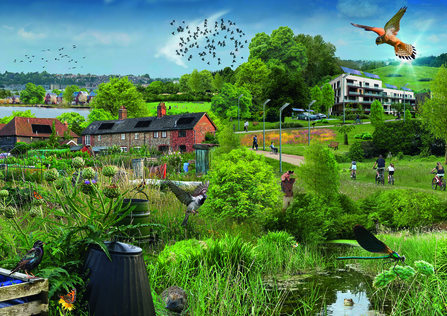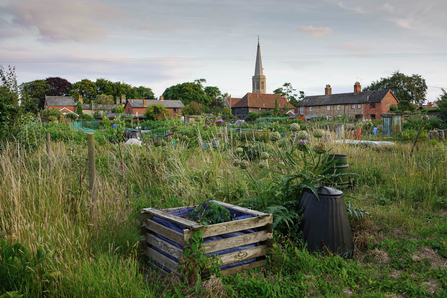Bringing nature back
As we celebrate our 60th year, Suffolk Wildlife Trust has created a bold vision to bring wildlife back, and together with the Wildlife Trust movement, we aim to restore 30% of land and sea for nature by 2030.
We’ve worked with illustrator Daniel Hilliard to create visual representations of a wildlife-rich rural landscape and an urban landscape to show how wild Suffolk could be if everyone considered nature in every decision we make.

Suffolk Wildlife Trust urban vision illustration, Dan Hilliard, 2021
We have lost so much, but through the actions of every single one of us, we can bring nature back.
If we are to ensure that 30% of our land and sea is protected for nature then a broad vision is needed to help us all get there. Business as usual cannot continue, and systemic changes are needed to make sure we protect what we have left and bring back what we’ve lost, creating ways to help isolated populations of species reconnect and travel freely once more throughout our land and town-scapes. Everyone should have access to nature too, so that it’s respected and cherished and front-of-mind when decisions are made.
What does a Wilder Suffolk in our towns and urban areas look like?
This image is a reflection of what a wilder Suffolk could look like: a place of wonder, abundance and diversity, rich in wildlife and us as part of it, where we give space for other species to thrive.
In parallel, we are launching Team Wilder which aims to create a tipping point of change for wildlife. We’re aiming to get 1 in 4 people doing their bit for wildlife in Suffolk to create societal change and build momentum towards a sustainable, healthy future for us all.
People
Wildlife is visible and thriving and is part of everyone’s lives, every day. It’s not just reserved for weekend trips to the countryside, it can be cherished at home and at work, constantly. Our lives are intertwined with it, as we welcome wildlife to our homes (for example by adding swift bricks or bird boxes), our gardens, our workplaces and communal areas.
Wild areas
More areas are allowed to go wild to help insects and everything that depends on them, including us! The tyranny of tidiness ends, and we allow wildflowers to thrive and hedges to blossom and fruit.
Once familiar species such as house sparrows and starlings are in decline. We can bring back abundance and diversity by creating more space for nature. Leaving wild areas for insects and allowing wild plants to seed creates natural food for birds, and connecting areas by wild verges, trees, hedgerows and water will allow species to travel and proliferate.
Wild gardens and allotments
Great for positive mental health, allotments and shared green spaces connect people with nature and provide great habitats for wildlife, too. Growing your own can mean zero food miles and zero plastic, too.
Wild gardens are not all neat and tidy but contain a variety of habitats and food for wildlife. Bird and insect boxes, bee hotels, hedgehog homes, lots of plants for pollinators, a small wildlife pond if there’s space, uncut areas of rough grass, hedgehog highways, log piles – there’s so much great habitat potential – and it can all be connected.

Green energy and transport
Commuting on foot and by bike is safe, healthy and easy, and energy is carbon-free. Walking helps give time for people to appreciate nature, and accessible and convenient public transport takes cars off the road and hence less damaging pollution and need for road building, fragmenting habitat.
Kind industry
As businesses evolve and innovate, and consumers demand more sustainable choices, industry can become non-damaging, working with nature and people and not against them.
Urban communal spaces
Parks, green spaces, ponds and lakes are great for bringing communities together and having a shared natural space to enjoy and cherish. Street trees, as well as being important landmarks, are valued by local communities, they provide great habitat and they keep us cool in the summer, too.
Darker night skies
Too much light at night is bad news for many species, particularly moths and bats. By keeping lights to just the necessities, we not only get to enjoy the night skies ourselves, but our wildlife will benefit, too.
Water
Clean water in our urban spaces creates homes for insects and attracts a host of other wildlife, too. Ponds, big or small, are brilliant places for wildlife.
How you can help
Suffolk Wildlife Trust is working with schools, organisations, businesses and individuals to help everyone make the right choices for nature. We’d love you to help too, by doing what you can to support wildlife at home, at work and in your local communities. We have lots of free resources and information on our website. Be part of #TeamWilder and help drive the change we need to see to turn wildlife decline around.
You can find out more about our vision for our rural landscapes here
